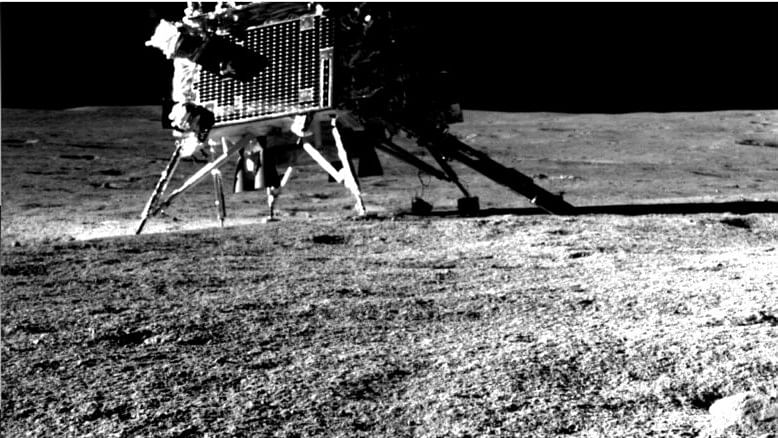
Vikram Lander, as clicked by the Navigation Camera onboard the Pragyan Rover.
Credit: X/@isro
Initial measurements carried out by an instrument on the Chandrayaan-3 lander Vikram have indicated that plasma (charged particles) encompassing the lunar surface is “relatively sparse”.
The findings are from the first in-situ measurements of the plasma environment conducted in the moon’s south polar region, by the Radio Anatomy of Moon Bound Hypersensitive ionosphere and Atmosphere – Langmuir Probe (RAMBHA-LP).
The Indian Space Research Organisation (ISRO) said on Thursday that these measurements could help in mitigating the noise lunar plasma introduces into radio wave communication and contribute to “enhanced designs” for upcoming lunar visitors.
Initial recordings, made during the early stages of the lunar day, have seen a number density ranging from approximately 5 to 30 million electrons per cubic metre.
The instrument comes with a 5-cm metallic, spherical probe mounted on a one-metre boom and attached to Vikram’s upper deck. Deployed through a hold-release mechanism, the probe, aided by the extended boom length, studies the undisturbed lunar plasma environment while staying detached from the lander’s body.
The system is equipped to detect minute return currents and by measuring them, accurately determine the ion and electron densities as well as their energies.
Operating without interruption, the instrument studies changes in the near-surface plasma environment happening throughout the lunar day.
“These ongoing observations hold significant implications for comprehending the process of charging within the lunar near-surface region, particularly in response to the fluctuations in solar space weather conditions,” ISRO said.
The probe is named after Irving Langmuir who was awarded the Nobel Prize in Chemistry, in 1932, for his discoveries and investigations in surface chemistry. The development of RAMBHA-LP was led by the Space Physics Laboratory, Vikram Sarabhai Space Centre, Thiruvananthapuram.
ILSA spots “natural” event
The Instrument for Lunar Seismic Activity (ILSA) on the lander has recorded a “seemingly natural” event on the lunar surface, on August 26. “The source of this event is currently under investigation,” ISRO said.
ILSA's primary objective is to measure ground vibrations generated by natural quakes, impacts, and artificial events. It has recorded the vibrations caused by movements of the rover and other payloads. Vikram is the first to carry a Micro Electro Mechanical Systems technology-based instrument on the moon.